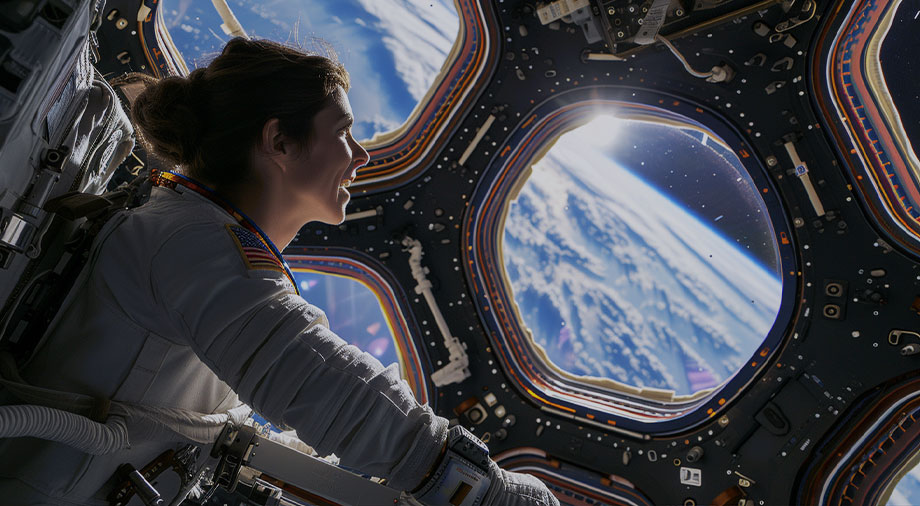Astronomy would be much less attractive to the general public if it were impossible to touch. By touch, we are referring to our ability as observers to try to sense and comprehend the cosmos.
In today’s world, planetariums are gateways into the world of astronomy — domed space theaters where the viewer can clearly examine down to the smallest detail what makes up outer space. The spherical dome of an observatory guides us to the very principles that once formed the foundation of the very science “of the celestial spheres.” Apparently, this is why the inner walls of these domes often act as orreries (mechanical models of the Solar System), and also serve as convex screens for showing large-format scientific films about our Universe using special spherical projectors.
Most planetariums also combine the functions of astronomy museums, allowing visitors to contemplate technical solutions and sometimes see real spacecraft that were used in past missions. For this article, we have compiled an exclusive selection of the most fascinating planetariums in the world to get our readers excited about astronomical science and exploring our Universe.
Eise Eisinga: the oldest operating planetarium in the world
Let us start our journey from the Dutch province of Friesland, where for 243 years, the city of Franeker has hosted the Eise Eisinga Planetarium – the oldest operating one on Earth. Its history began in 1781, when the planetarium first opened its doors in the home of wool carder Eise Eisinga.
The ceiling of the observatory was decorated with a mechanical model of the solar system created by Eise Eisinga, an amateur astronomer in the 18th century who sought to describe the cycles of movement of the planets and satellites. The orrery on the ceiling of the Eise Eisinga was an incredibly accurate instrument for its time. The system of weights and counterweights in the orrery mechanism (which Eisinga made from a clock pendulum) was adjusted so precisely that it still remains a valid physical model, and demonstrates the intervals of movement of celestial bodies in our Solar System as close as possible to real time. Even the orbital period of the miniature Moon around the gilded model of the Earth here is 27.32 days.
According to legend, Eisinga, a wool carder by trade, built the planetarium to refute a prophecy about the imminent end of the world, which was spread by the Frisian priest Eelco Alta. According to the theologian’s statements, the end was to come from a “quick and inevitable” collision of the planets of the solar system with each other. Therefore, in an effort to dispel these rumors and clearly demonstrate to the townspeople the cyclical principle of the movement of celestial objects, Eise Eisinga decided to erect a miniature illustration of our solar system in his living room.
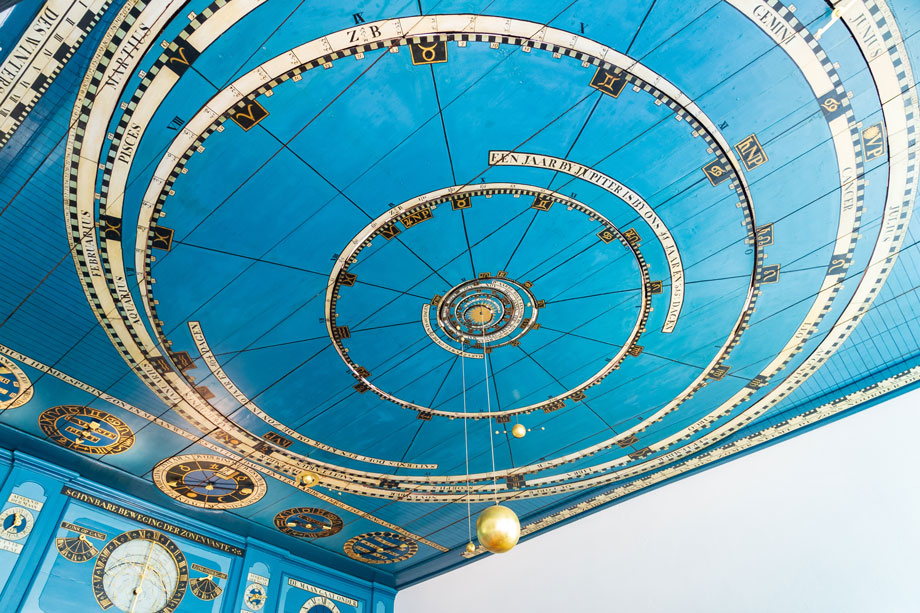
Source: shutterstock.com
At the beginning of its creation on the ceiling orrery at the end of the 18th century, there were only six planets of the solar system known: Mercury, Venus, Earth, Mars, Jupiter and Saturn. Later, astronomical science will go further and discover other objects in the solar system, but the ceiling design in the Eise Eisinga Planetarium remains the way its creator intended it
In September 2023, the Eise Eisinga House Planetarium Museum was added to the UNESCO World Heritage List. The planetarium’s management predicts that this will attract new visitors, but even without this designation, the planetarium averaged about 60,000 visitors per year. The Eise Eisinga Planetarium is a wonderful piece of Dutch astronomical history that you have likely never heard of before.
Planetarium of the German Museum in Munich
Although the Eise Eisinga Planetarium was founded in the Netherlands in the 18th century, the classic view of planetariums as astronomical cinemas with spherical film projectors displaying images of stars and space on a domed ceiling did not appear until the 20th century. It was this video format for explaining astronomy that was proposed by the planetarium of the German Museum in Munich, opened by Oscar von Miller 99 years ago – on May 7, 1925.
The German Museum received two planetariums at once. The first was the Copernicus Planetarium, dedicated to the movement of celestial bodies in the solar system. The second, Ptolemaic Planetarium, was the first in the world to be equipped with a Görz reflecting telescope, located in the eastern dome, and an innovative Zeiss refracting lens telescope, developed by Carl Zeiss Jena.
The device made it possible to reproduce on a screen a projection of the position of 4,500 stars in the Milky Way and operated in three main operating modes: with a simulation of the daily rotation of the Earth and stars in 50 seconds, two minutes, and four minutes. At first, the star projection was reproduced only for the latitude of Munich, but later more precise Zeiss settings made it possible to simulate the view of the night sky from anywhere in the world.
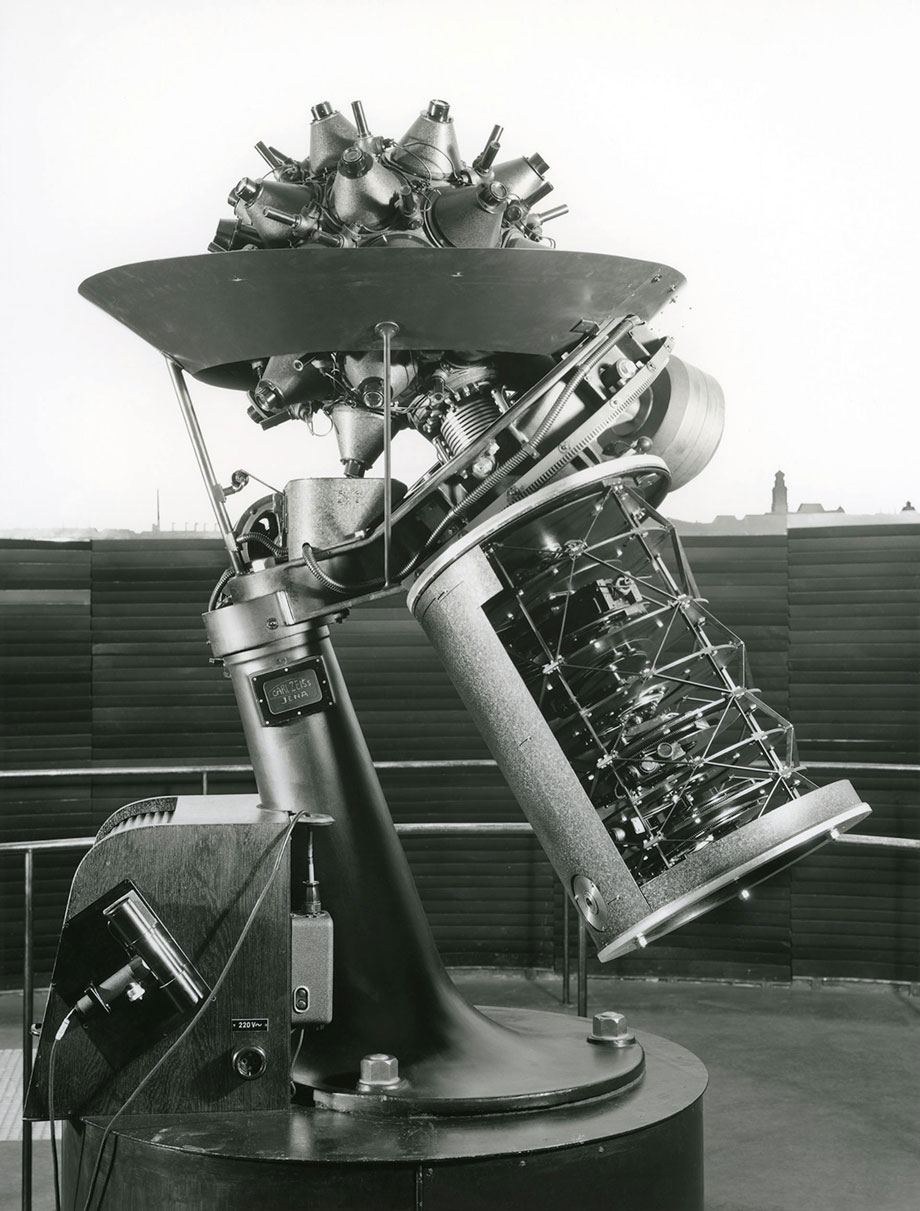
Source: images.zeiss.com
In the future, the technology of Zeiss series lens spherical projectors, designed by Walter Bauersfeld, will be distributed throughout the world. Today, their later modifications can be found in almost every major planetarium on the planet. Unfortunately, right now the oldest projection planetarium in Europe is undergoing its next renovation – in 2022, the planetarium hall was closed for a six-year reconstruction. Thus, visiting the planetarium of the German Museum in Munich with its new technical equipment will only be possible in 2028.
The Hayden Planetarium: the largest solar system model and star director
New York’s Hayden Planetarium is part of the Rose Center for Earth and Space, and first opened its doors in 1935 in Central Park. However, back then it had a completely different look, because in 1997 the original building was demolished after a bold decision to completely reconstruct the planetarium and significantly expand its size. Therefore, all that remains of the original today are photographs.
Reconstruction of the Hayden Planetarium, which ended only in 2000, marked the appearance of the legendary Hayden Sphere in its exhibition. The Sphere, which is one of the largest static models of the solar system, is located in a glass cube of a six-story planetarium building (the so-called Kalman Hall of the Universe). The sphere demonstrates the real size ratios of celestial objects in our solar system. The new building was designed by James Polshek and Todd Schlieman.
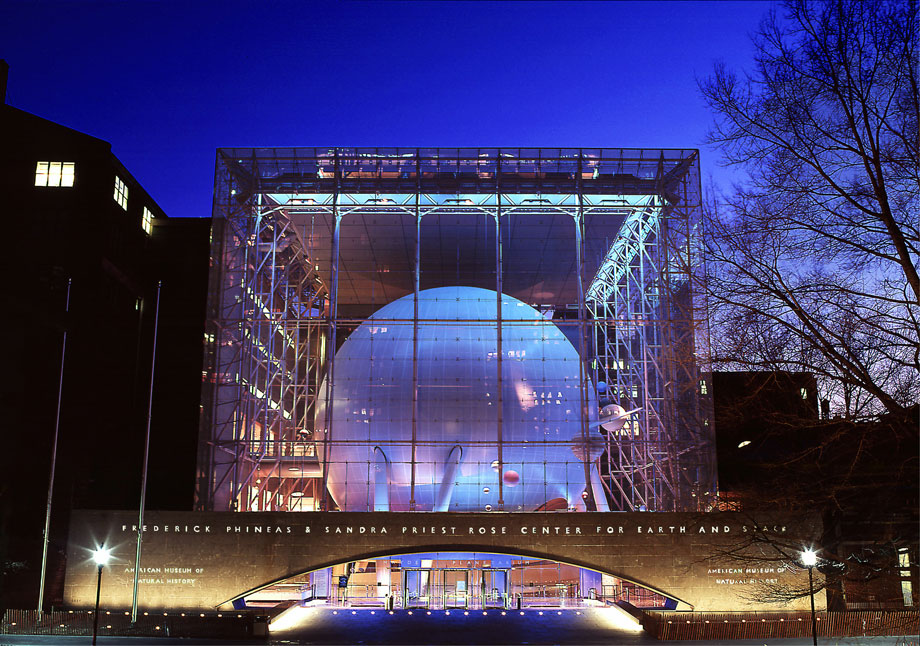
Source: media.timeout.com
The main exhibition of the Hayden Planetarium is located in the Kalman Hall of the Universe, whose area is about 6000 m2. The exhibition is dedicated to the emergence of our Universe and the process of formation of the Solar system; in its center is a model of the Sun, called the Hayden Sphere. This huge ball amazes not only with its size. Inside it is the Star Theater, a hall for broadcasting films on a screen on the rounded inner ceiling of the planetarium.
After renovations in 1999-2000, the Hayden Planetarium received new equipment to display its science films in high definition. It was a Zeiss Mark IX spherical projector accompanied by a digital system capable of making a 3D visualization of the universe from images generated in real time by a Silicon Graphics computer.
In 2019, during celebrations of the 50th anniversary of the Moon landing, the planetarium was presented with six – Christie Eclipse RGB high dynamic range HDR laser projectors. The latest projectors are capable of delivering brighter, richer colors without unwanted residual light levels, and also deliver UHD (4K) video at 60 frames per second.
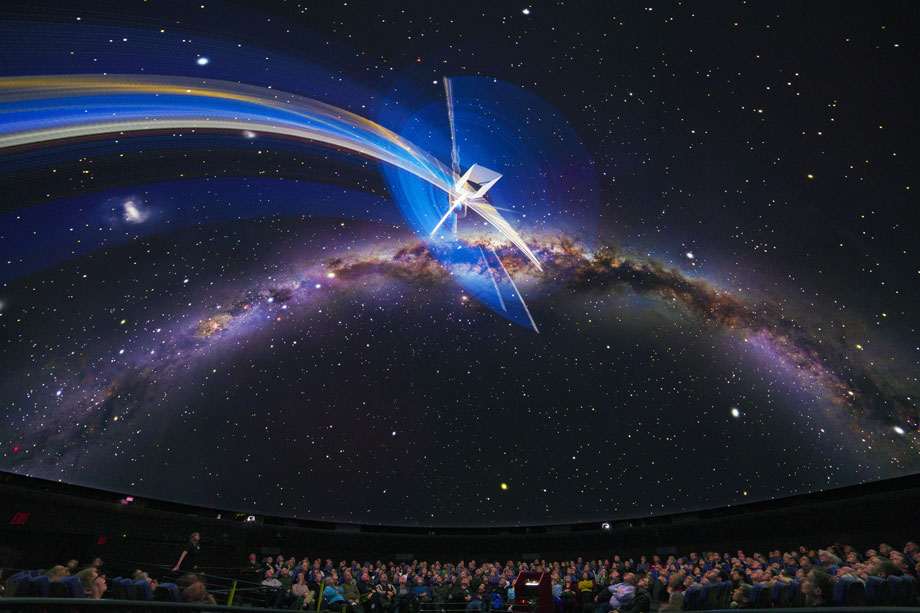
Source: www.boxofficepro.com
The Hayden Planetarium is interesting not only for its exhibition, but also for its management. Today its director is one of the world’s most famous popularizers of astronomy, Neil deGrasse Tyson. He has held this position since 1996, and played a key role in the planetarium’s renovation at the turn of the millennium. Tyson is now the first and so far only director of the updated Hayden Planetarium.
Of course, Tyson uses his own media popularity to bring Hollywood celebrity friends to the planetarium. Over the past 24 years, Hayden Planetarium’s science education shows have featured stars such as Tom Hanks, Robert Redford, Harrison Ford, Whoopi Goldberg and many other prominent artists of our time. Perhaps nowhere else in the world will you find such a successful combination of earthly and heavenly stars.
Nagoya Science Museum Planetarium
Another amazing planetarium and part-time astronomical museum is located in the Japanese city of Nagoya. This object amazes not only with its internal exposition, but also with its outstanding architecture. The history of the Science Museum in Nagoya goes back only 12 years, but it rightfully deserves an honorable place on our list.
The huge metal planetarium sphere called Brother Earth, where science films are shown, is located directly between the museum’s two main buildings: the Life Sciences House (dealing mainly with biology and anatomy) and the Science and Technology House (covering the history of physical sciences). The domed metal sphere of the planetarium connects these two museums to each other, forming a single common space.

Source: shutterstock.com
Japanese is not the easiest language for foreigners to understand. That is why the Nagoya Planetarium made sure that non-Japanese-speaking visitors could enjoy the museum’s with a special smartphone app that translates the inscriptions on all museum exhibits into English, Chinese, or Korean.
The planetarium’s spherical dome is 35 m in diameter, and can hold up to 350 spectators in its hall at a time. That makes Nagoya Science Museum’s planetarium the second largest in the world (Unfortunately, the top spot is held by a planetarium in St. Petersburg, which, for obvious reasons, has no place in our selection).
Adler Planetarium: America’s Oldest Planetarium
In 1930, American businessman and philanthropist Max Adler founded the first planetarium in the United States (and the first outside Europe) in Chicago, which was named in his honor: the Adler Planetarium. At first, the facility was planned to be built as part of the Chicago Museum of Science and Industry, but later the project became completely independent and moved further down the shores of Lake Michigan to its own spot.
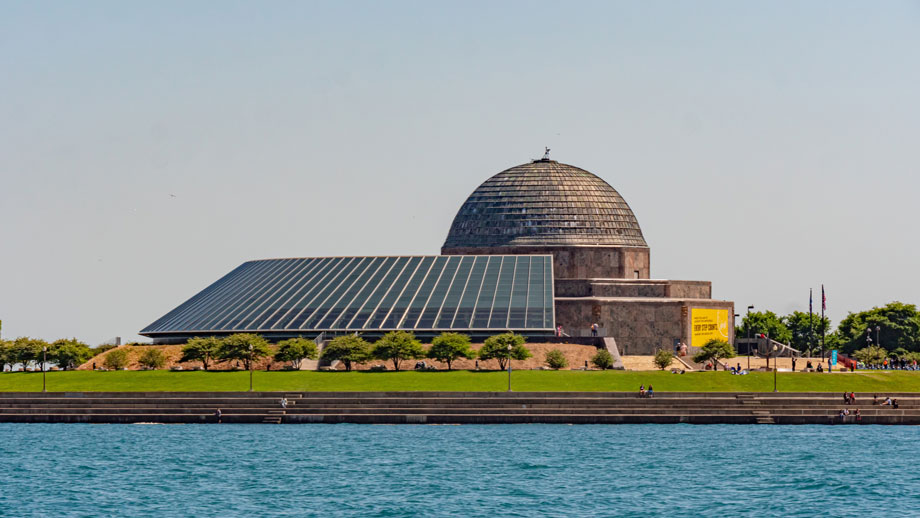
At the time of the planetarium’s opening, its Zeiss Mark II spherical film projector (the first model of which appeared at the Munich planetarium ten years earlier) was a real technological marvel not only in the United States, but throughout the world. The movie projector weighed almost a ton and rotated 360°, projecting images of more than 4,500 stars onto the inside of the planetarium dome. The first replacement of the film projector took place on the planetarium’s 39th anniversary and coincided with NASA’s landing of astronauts on the Moon during the Apollo 11 mission in 1969.
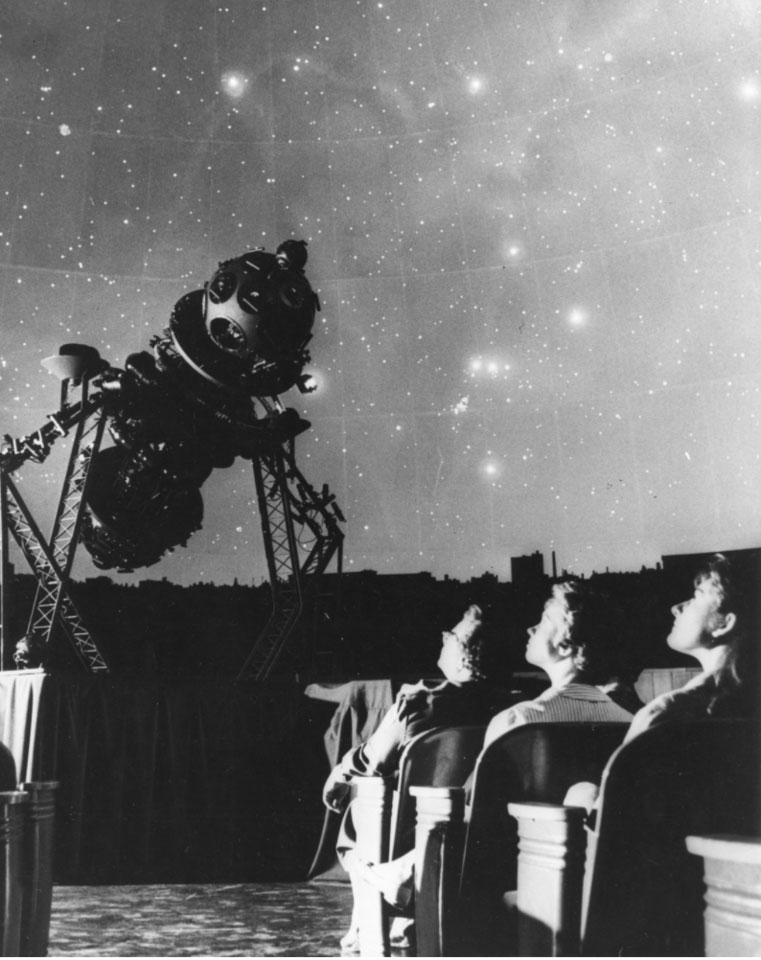
Source: www.adlerplanetarium.org
Despite its age and relatively small size, the Adler Planetarium has always kept itself up-to-date, constantly replenishing its exhibitions and modernizing the equipment of its spherical cinema hall. Its dome theater today can accommodate up to 199 visitors, and the projector was completely modernized in 2011.
The permanent exhibition at the Adler Planetarium contains an exact replica of the American Gemini 12 spacecraft, which NASA used during its lunar missions. The spacecraft is located in the planetarium hall dedicated to lunar exploration. The space is also known for its famous “Moon Wall”, which allows visitors to experience free flight over the surface of Earth’s moon in a special simulation room.
More than 400,000 people visit the Adler Planetarium every year, the vast majority of whom are schoolchildren and students. Every year, the Adler Planetarium not only puts on exciting astronomical shows, but also hosts conferences under its roof, where the astronomical community has the opportunity to make presentations and engage in scientific debate.
Galileo Galilei Planetarium: the largest exhibition of meteorites in South America
Argentina has never flown to the Moon, but it nevertheless hosts some of the lunar rock brought by American astronauts from the Apollo 11 mission. The most famous planetarium in Argentina and South America, the Galileo Galilei Planetarium in Buenos Aires, has this honor thanks to a gift by US President Richard Nixon.
The Galileo Galilei Planetarium opened in 1966 in Tres de Febrero Park, in the neighborhood of Palermo. The location was not chosen by chance, as it was the location of the first ever official soccer match in Argentina in 1867. It took place between a local cricket club and the crew of the British warship Bombay, which brought the sport to the continent. It seems that there is nothing in Argentina which can exist without soccer , even when it comes to studying the stars.
The Galileo Galilei Planetarium is a true reflection of its time. The sixties left a visible imprint on the design of the building, as it looks like a spaceship from the era’s science fiction films.
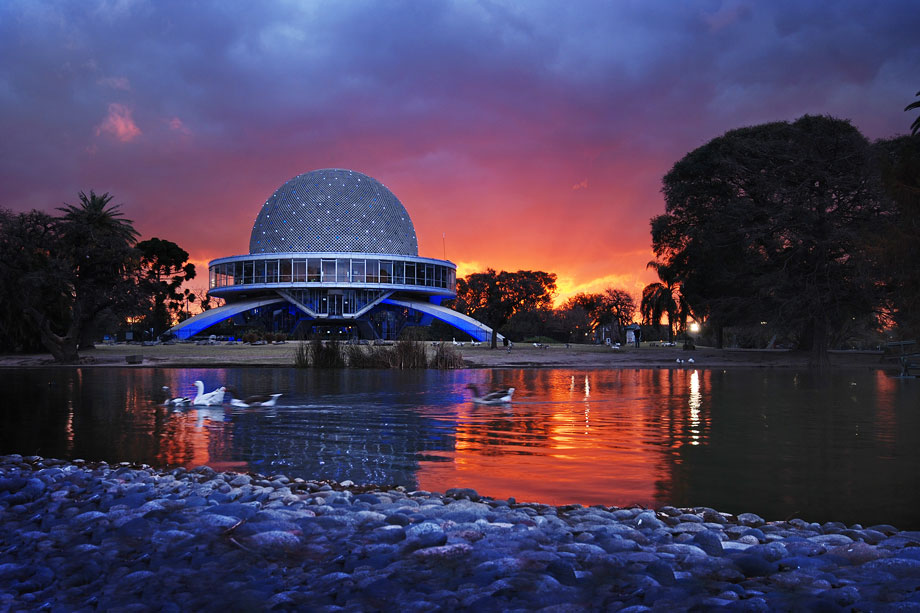
Source: shutterstock.com
The planetarium’s exhibition holds three steel meteorites found in Argentina. One of the institution’s unique features is that it operates in the evening, allowing its visitors to view the stars not only on the projector screen, but also through telescopes installed at the planetarium. The 20-meter dome allows the planetarium’s projector to show a display of 8900 fixed stars.
The Galileo Galilei Planetarium was renovated twice over the course of the 20th century. In 2011, the planetarium received a new Zeiss Mark V spherical film projector. In 2017, its main building was expanded, and repairs were made to the dome’s structure. Perhaps the only drawback of the planetarium is that it is not the most hospitable to foreign visitors – for almost 60 years, all exhibitions and films have been exclusively in Spanish.
Birla Planetarium in India
Last year, India forever etched its name in global astronautics by successfully delivering its Chandrayaan-3 spacecraft to the lunar south pole. It is quite likely that many of the Indian specialists who worked on this space mission were first inspired by visiting the Birla Planetarium in Kolkatta, West Bengal.
The planetarium first opened on July 2, 1963 and was almost immediately recognized as the largest in Asia (which it still retains). Its domed hall with a diameter of 23 m can accommodate up to 570 visitors.
The Birla Planetarium only offers its visitors more than just astronomical shows. Inside the building there is an electronics laboratory for the design and manufacture of scientific equipment for space activities. The external exhibition consists of an astronomical gallery containing a huge collection of space-related paintings and physical models of celestial objects. The Birla Planetarium also houses an astronomical observatory equipped with a Celestron C-14 solar filter telescope. The telescope is constantly used for teaching and research by Indian astronomy students.
The interactive format of the planetarium is represented by visual shows demonstrated using the Starmaster projector (also known as Starball) from the German company Carl Zeiss AG. The planetarium acquired its latest spherical projector during renovations in 2017.
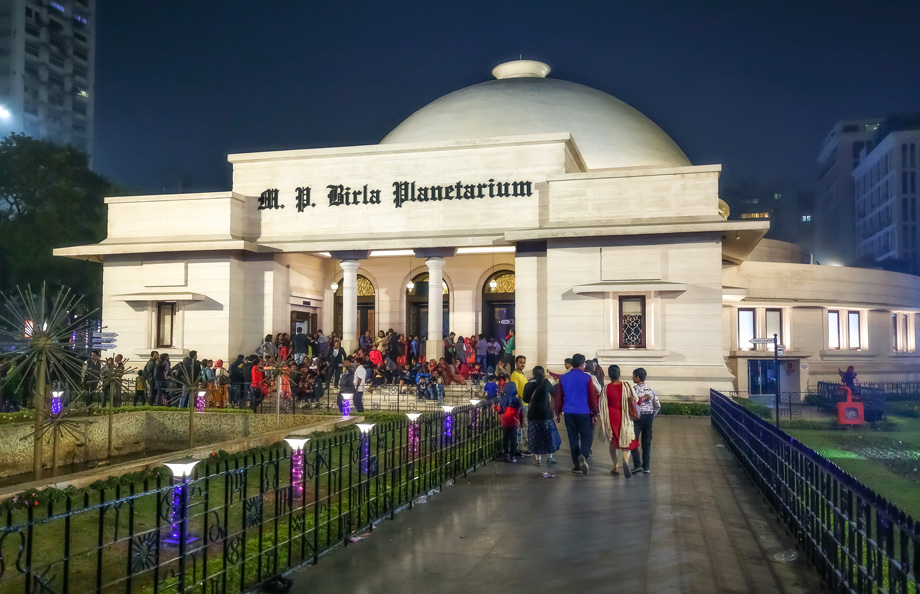
Source: shutterstock.com
The Starmaster projector works in sync with the video dome display system to produce the most realistic star field in the dome with superimposed images of the outlines of constellations, space objects, nebulae, galaxies, planets and satellites using the Velvet digital video system.
The Birla Planetarium is not only in Kolkata. It also has branches in Chennai and Hyderabad, but both buildings are half the size of the original.
We hope that one day, our readers will be able to visit many of these amazing planetariums. Stay tuned for updates on our website, as we will soon be sharing an article about the most interesting astronomy and aerospace museums on the planet.



